Earth's rotation: Difference between revisions
Luckas-bot (talk | contribs) m r2.7.1) (robot Adding: ca:Rotació de la Terra |
|||
| Line 48: | Line 48: | ||
== Foucault pendulum == |
== Foucault pendulum == |
||
The most celebrated test of Earth's rotation is the [[Foucault pendulum]] first built by physicist [[Léon Foucault]] in 1851, which consisted of an iron sphere suspended {{nowrap|67 m}} from the top of the [[Panthéon (Paris)|Panthéon]] in Paris. Because of the Earth's rotation under the swinging pendulum the pendulum's plane of oscillation appears to rotate at a rate depending on latitude. At the latitude of Paris the predicted and observed shift was about {{nowrap|11 degrees}} [[clockwise]] per hour. Foucault pendulums now swing in [[List of Foucault pendulums|museums around the world]]. |
The most celebrated test of Earth's rotation is the [[Foucault pendulum]] first built by physicist [[Léon Foucault]] in 1851, which consisted of an iron sphere suspended {{nowrap|67 m}} from the top of the [[Panthéon (Paris)|Panthéon]] in Paris. Because of the Earth's rotation under the swinging pendulum the pendulum's plane of oscillation appears to rotate at a rate depending on latitude. At the latitude of Paris the predicted and observed shift was about {{nowrap|11 degrees}} [[clockwise]] per hour. Foucault pendulums now swing in [[List of Foucault pendulums|museums around the world]].fuck u |
||
== See also == |
== See also == |
||
Revision as of 19:00, 11 February 2011
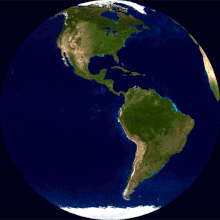
Earth's rotation is the rotation of the solid Earth around its own axis. The Earth rotates towards the east. As viewed from the North Star Polaris, the Earth turns counter-clockwise.
Rotation period
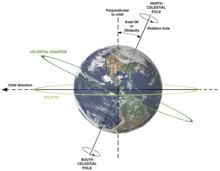
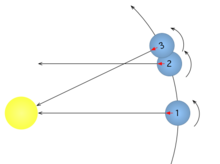
Earth's rotation period relative to the Sun (true noon to true noon) is its true solar day or apparent solar day. It is the derivative of the equation of time and thus depends on the eccentricity of Earth's orbit and the tilt (obliquity) of Earth's axis. Both vary over thousands of years[1] so the annual variation of the true solar day also varies. Generally, it is longer than the mean solar day twice a year and shorter twice a year.[n 1] The true solar day tends to be longer near perihelion when the Sun apparently moves along the ecliptic through a greater angle than usual, taking about 10 seconds longer to do so. Conversely, it is about 10 seconds shorter near aphelion. It is about 20 seconds longer near a solstice when the projection of the Sun's apparent movement along the ecliptic onto the celestial equator causes the Sun to move through a greater angle than usual. Conversely, near an equinox the projection onto the equator is shorter by about 20 seconds. Currently, the perihelion and solstice effects combine to lengthen the true solar day near December 22 by 30 mean solar seconds, but the solstice effect is partially cancelled by the aphelion effect near June 19 when it is only 13 seconds longer. The effects of the equinoxes shorten it near March 26 and September 16 by 18 seconds and 21 seconds, respectively.[2][3][4]
The average of the true solar day over an entire year is the mean solar day, which contains 86,400 mean solar seconds. Currently, each of these seconds is slightly longer than an SI second because Earth's mean solar day is now slightly longer than it was during the 19th century due to tidal friction. The average length of the mean solar day since the introduction of the leap second in 1972 has been about 0 to 2 ms longer than 86,400 SI seconds.[5][6][7] Random fluctuations due to core-mantle coupling have an amplitude of about 5 ms.[8][9] The mean solar second between 1750 and 1892 was chosen in 1895 by Simon Newcomb as the independent unit of time in his Tables of the Sun. These tables were used to calculate the world's ephemerides between 1900 and 1983, so this second became known as the ephemeris second. The SI second was made equal to the ephemeris second in 1967.[10]
Earth's rotation period relative to the fixed stars, called its stellar day by the International Earth Rotation and Reference Systems Service (IERS), is 86,164.098 903 691 seconds of mean solar time (UT1) (23h 56m 4.098 903 691s, 0.997 269 663 237 16 mean solar days).[11][n 2] Earth's rotation period relative to the precessing or moving mean vernal equinox, misnamed its sidereal day,[n 3] is 86,164.090 530 832 88 seconds of mean solar time (UT1) (23h 56m 4.090 530 832 88s, 0.997 269 566 329 08 mean solar days).[11] Thus the sidereal day is shorter than the stellar day by about 8.4 ms.[13] In 499 CE Aryabhata, a great mathematician-astronomer from the classical age of Indian mathematics and Indian astronomy estimated the length of sidereal day as 23h 56m 4.1s [14].
Both the stellar day and the sidereal day are shorter than the mean solar day by about 3 minutes 56 seconds. The mean solar day in SI seconds is available from the IERS for the periods 1623–2005[15] and 1962–2005.[16]
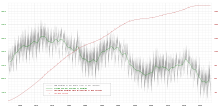
Recently (1999–2010) the average annual length of the mean solar day in excess of 86,400 SI seconds has varied between 0.25 ms and 1 ms, which must be added to both the stellar and sidereal days given in mean solar time above to obtain their lengths in SI seconds.
The angular speed of Earth's rotation in inertial space is (7.2921150 ± 0.0000001) ×10−5 radians per SI second (mean solar second).[11] Multiplying by (180°/π radians)×(86,400 seconds/mean solar day) yields 360.9856°/mean solar day, indicating that Earth rotates more than 360° relative to the fixed stars in one solar day. Earth's movement along its nearly circular orbit while it is rotating once around its axis requires that Earth rotate slightly more than once relative to the fixed stars before the mean Sun can pass overhead again, even though it rotates only once (360°) relative to the mean Sun.[n 4] Multiplying the value in rad/s by Earth's equatorial radius of 6,378,137 m (WGS84 ellipsoid) (factors of 2π radians needed by both cancel) yields an equatorial speed of 465.1 m/s, 1,674.4 km/h or 1,040.4 mi/h.[17] Some sources state that Earth's equatorial speed is slightly less, or 1,669.8 km/h.[18] This is obtained by dividing Earth's equatorial circumference by 24 hours. However, the use of only one circumference unwittingly implies only one rotation in inertial space, so the corresponding time unit must be a sidereal hour. This is confirmed by multiplying by the number of sidereal days in one mean solar day, 1.002 737 909 350 795,[11] which yields the equatorial speed in mean solar hours given above of 1,674.4 km/h.
The angular speed of Earth's rotation at a point on Earth can be approximated by multiplying the speed at the equator by the cosine of the latitude.[19] For example, the Kennedy Space Center is located at 28.59° North latitude yields speed: 1,674|km/hr * cos (28.59) = 1,470.23 kilometres per hour (913.56 mph)
The permanent monitoring of the Earth's rotation requires the use of Very Long Baseline Interferometry coordinated with the Global Positioning System, Satellite laser ranging, and other satellite techniques. This provides the absolute reference for the determination of universal time, precession, and nutation.[20]
Over millions of years, the rotation is significantly slowed by gravitational interactions with the Moon: see tidal acceleration. However some large scale events, such as the 2004 Indian Ocean earthquake, have caused the rotation to speed up by around 3 microseconds.[21] Post-glacial rebound, ongoing since the last Ice age, is changing the distribution of the Earth's mass thus affecting the Moment of Inertia of the Earth and, by the Conservation of Angular Momentum, the Earth's rotation period.[22]
Precession, nutation, and polar motion
The Earth's rotation axis moves with respect to the fixed stars (inertial space); the components of this motion are precession and nutation. The Earth's rotation axis also moves with respect to the Earth's crust; this is called polar motion.
Precession is a rotation of the Earth's rotation axis, caused primarily by external torques from the gravity of the Sun, Moon and other bodies. The polar motion is primarily due to free core nutation and the Chandler wobble.
Physical effects
The velocity of the rotation of Earth has had various effects over time, including the Earth's shape (an oblate spheroid), climate, ocean depth and currents, and tectonic forces.[23]
Origin
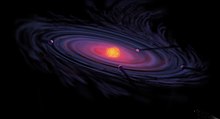
It is theorized that Earth formed as part of the birth of the Solar System: what eventually became the solar system initially existed as a large, rotating cloud of dust, rocks, and gas. It was composed of hydrogen and helium produced in the Big Bang, as well as heavier elements ejected by supernovas. As this interstellar dust is inhomogeneous, any asymmetry during gravitational accretion results in the angular momentum of the eventual planet.[24] The current rotation period of the Earth is the result of this initial rotation and other factors, including tidal friction and the hypothetical impact of Theia.
Evidence of Earth's rotation
In the Earth's rotating frame of reference, a freely moving body follows an apparent path that deviates from the one it would follow in a fixed frame of reference. Because of this Coriolis effect, falling bodies veer eastward from the vertical plumb line below their point of release, and projectiles veer right in the northern hemisphere (and left in the southern) from the direction in which they are shot. The Coriolis effect has many other manifestations, especially in meteorology, where it is responsible for the differing rotation direction of cyclones in the northern and southern hemispheres. Hooke, following a 1679 suggestion from Newton, tried unsuccessfully to verify the predicted half millimeter eastward deviation of a body dropped from a height of 8.2 meters, but definitive results were only obtained later, in the late 18th and early 19th century, by Giovanni Battista Guglielmini in Bologna, Johann Friedrich Benzenberg in Hamburg and Ferdinand Reich in Freiberg, using taller towers and carefully released weights.[n 5]
Foucault pendulum
The most celebrated test of Earth's rotation is the Foucault pendulum first built by physicist Léon Foucault in 1851, which consisted of an iron sphere suspended 67 m from the top of the Panthéon in Paris. Because of the Earth's rotation under the swinging pendulum the pendulum's plane of oscillation appears to rotate at a rate depending on latitude. At the latitude of Paris the predicted and observed shift was about 11 degrees clockwise per hour. Foucault pendulums now swing in museums around the world.fuck u
See also
- Geodesy
- Important publications in geodesy
- History of geodesy, Space techniques
- World Geodetic System, WGS 84
- Geodesic (in mathematics)
- Geodesic (in physics)
- Allais effect
- History of Earth
- Formation and evolution of the Solar System
- Diurnal cycle
- Spherical Earth
Notes
- ^ When Earth's eccentricity exceeds 0.047 and perihelion is at an appropriate equinox or solstice, only one period with one peak balances another period that has two peaks.[2]
- ^ Aoki, the ultimate source of these figures, uses the term "seconds of UT1" instead of "seconds of mean solar time".[12]
- ^ Sidereal day is arguably a misnomer because the dictionary definition of sidereal is "relating to the stars", thus fostering confusion with the stellar day.
- ^ In astronomy, unlike geometry, 360° means returning to the same point in some cyclical time scale, either one mean solar day or one sidereal day for rotation on Earth's axis, or one sidereal year or one mean tropical year or even one mean Julian year containing exactly 365.25 days for revolution around the Sun.
- ^ See Fallexperimente zum Nachweis der Erdrotation (German Wikipedia article).
References
- ^ Derivation of the equation of time
- ^ a b Jean Meeus, Mathematical astronomy morsels (Richmond, Virginia: Willmann-Bell, 1997) 345–6.
- ^ Equation of time in red and true solar day in blue
- ^ The duration of the true solar day
- ^ http://hpiers.obspm.fr/eoppc/eop/eopc04_05/eopc04.62-now
- ^ Physical basis of leap seconds
- ^ Leap seconds
- ^ Prediction of Universal Time and LOD Variations
- ^ R. Hide et al., "Topographic core-mantle coupling and fluctuations in the Earth's rotation" 1993.
- ^ Leap seconds by USNO
- ^ a b c d IERS EOP Useful constants
- ^ Aoki, et al., "The new definition of Universal Time", Astronomy and Astrophysics 105 (1982) 359–361.
- ^ Explanatory Supplement to the Astronomical Almanac, ed. P. Kenneth Seidelmann, Mill Valley, Cal., University Science Books, 1992, p.48, ISBN 0-935702-68-7.
- ^ Aryabhatiya Marathi: आर्यभटीय, Mohan Apte, Pune, India, Rajhans Publications, 2009, p.25, ISBN 978-81-7434-480-9
- ^ IERS Excess of the duration of the day to 86,400s … since 1623 Graph at end.
- ^ IERS Variations in the duration of the day 1962–2005
- ^ Arthur N. Cox, ed., Allen's Astrophysical Quantities p.244.
- ^ Michael E. Bakich, The Cambridge planetary handbook, p.50.
- ^ Butterworth and Palmer. "Speed of the turning of the Earth". Ask an Astrophysicist. NASA Goddard Spaceflight Center.
- ^ Permanent monitoring
- ^ Sumatran earthquake sped up Earth's rotation, Nature, December 30, 2004.
- ^ Wu, P. (1984). "Pleistocene deglaciation and the earth's rotation: a new analysis". Geophysical Journal of the Royal Astronomical Society. 76: 753–792.
{{cite journal}}: Unknown parameter|coauthors=ignored (|author=suggested) (help) - ^ Physical effects
- ^ "Why do planets rotate?". Ask an Astronomer.
External links
- Earth Orientation Center: Earth rotation data and interactive analysis
- Reason for Earth's rotation
- Why is the earth rotating ?
- Weather Makes Earth Wobble
- Earth rotation by Jean O. Dickey
- International Earth Rotation and Reference Systems Service (IERS)
- AAM Scientific Background Information (1.36 MB pdf file)
- Historical Eclipses and Earth’s rotation by F. Richard Stephenson (242KB pdf file)
- Spinning earth animation
